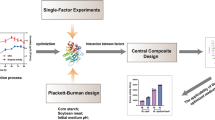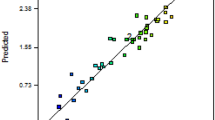Abstract
Sequential methodology based on the application of three types of experimental designs was used to optimize the fermentation conditions for elastase production from mutant strain ZJUEL31410 of Bacillus licheniformis in shaking flask cultures. The optimal cultivation conditions stimulating the maximal elastase production consist of 220 r/min shaking speed, 25 h fermentation time, 5% (v/v) inoculums volume, 25 ml medium volume in 250 ml Erlenmeyer flask and 18 h seed age. Under the optimized conditions, the predicted maximal elastase activity was 495 U/ml. The application of response surface methodology resulted in a significant enhancement in elastase production. The effects of other factors such as elastin and the growth factor (corn steep flour) on elastase production and cell growth were also investigated in the current study. The elastin had no significant effect on enzyme-improved production. It is still not clear whether the elastin plays a role as a nitrogen source or not. Corn steep flour was verified to be the best and required factor for elastase production and cell growth by Bacillus licheniformis ZJUEL31410.
Similar content being viewed by others
References
Box, G.E.P., Wilson, K.B., 1951. On the experimental attainment of optimum conditions. J. Roy Stat. Soc. B, 13: 145.
Box, G.E.P., Hunter, W.G., 1978. Statistics for Experimenters. John Wiley and Sons, NY.
Box, G.E.P., Draper, N.R., 1987. Empirical Model-Building and Response Surfaces. John Wiley and Sons, NY, p.669.
Chen, Q.H., He, G.Q., Mokhtar, A.M.A., 2002. Optimization of medium composition for the production of elastase by Bacillus sp. EL31410 with response surface methodology. Enzyme Microb. Technol., 30(5):667–672. [doi:10.1016/S0141-0229(02)00028-5]
Chen, Q.H., He, G.Q., Schwarz, P., 2004. Studies on cultivation kinetics for elastase production by Bacillus sp. EL31410. J. Agric. Food Chem., 52(11):3356–3359. [doi:10.1021/jf0303161]
Clark, D.J., Hawrylik, S.J., Kavanagh, E., Opheim, D.J., 2000. Purification and characterization of a unique alkaline elastase from Micrococcus luteus. Protein Expr. Purif., 18(1):46–55. [doi:10.1006/prep.1999.1166]
de O. Souza, M.C., Roberto, I.C., Milagres, A.M.F., 1999. Solid-state fermentation for xylanase production by Thermoascus aurantiacus using response surface methodology. Appl. Microbial. Biotechnol., 52(6):768–772. [doi:10.1007/s002530051589]
Haaland, P.D., 1989. Experimental Design in Biotechnology. Dekker, New York.
He, G.Q., Chen, Q.H., Ju, X.J., Shi, N.D., 2004. Improved elastase production by Bacillus sp. EL31410-further optimization and kinetics studies of culture medium for batch fermentation. J. Zhejiang Univ. Sci., 5(2):149–156. [doi:10.1631/jzus.2004.0149]
Janda, J.M., Abbott, S., 1999. Identification and initial characterization of elastase activity associated with Vibrio cholerae. Curr. Microbiol., 39(2):73–78. [doi:10.1007/s002849900421]
Kalil, S.J., Maugeri, F., Rodrigues, M.I., 2000. Response surface analysis and simulation as a tool for bioprocess design and optimization. Process Biochem., 35(6):539–550. [doi:10.1016/S0032-9592(99)00101-6]
Kapat, A., Jung, J.K., Park, Y.H., 2001. Enhancement of glucose oxidase production in batch cultivation of recombination Saccharomyces cerevisiae: optimization of oxygen transfer condition. J. Appl. Microbiol., 90(2):216–222. [doi:10.1046/j.1365-2672.2001.01233.x]
Khuri, A.I., Cornell, J.A., 1987. Response Surfaces Design and Analysis. Dekker, NY.
King, V.A., 1983. Studies on the control of the growth of Saccharomyces cerevisiae by using response surface methodology to achieve effective preservation at high water activities. Int. J. Food Sci. Technol., 28:519–529.
Ma, A.Y.M., Ooraikul, B., 1986. Optimization of enzymatic hydrolysis of canola meal with response surface methodology. J. Food Proc. Preserv., 10(2):99–113. [doi:10.1111/j.1745-4549.1986.tb00010.x]
Miller, G.L., 1959. Use of dinitrosalicylic acid reagent for determination of reducing sugar. Anal. Chem., 31(3):426–427. [doi:10.1021/ac60147a030]
Montgomery, D.C., 1997. Response Surface Methods and Other Approaches to Process Optimization. In: Montgomery, D.C. (Ed.), Design and Analysis of Experiments. John Wiley and Sons, NY, p.427–510.
Morihara, K., 1967. Elastolytic properties of various proteinase from microbial origin. Arch. Biochem. Biophys., 120(1):68–78. [doi:10.1016/0003-9861(67)90599-1]
Ozaki, H., Shiio, I., 1975. Purification and properties of elastolytic enzyme from Flavobacterium immotum. J. Biochem., 77:171–180.
Ramirez, J., Gutierrez, H., Gschaedler, A., 2001. Optimization of astaxanthin production by Phaffia rhodozyma through factorial design and response surface methodology. J. Biotechnol., 88(3):259–268. [doi:10.1016/S0168-1656(01)00279-6]
Roseiro, J.C., 1992. Medium development for xanthan production. Process Biochem., 27(3):167–175. [doi:10.1016/0032-9592(92)87005-2]
Rosi, I., Costamagna, L., Bertuccioli, M., 1987. Wine Fermentation by Immobilized Yeast: An Optimization Study. In: Flavor Science and Technology. John Wiley and Sons, NY.
Sacher, L.A., 1955. Photometry method for estimation of elastase activity. Proc. Soc. Exp. Biol. Med., 90:323–325.
Shibata, Y., Fujimura, S., Nakamura, T., 1993. Purification and partial characterization of an elastolytic serine protease of Prevotella intermedia. Appl. Environ. Microbial., 7:2107–2111.
Shiio, I., Nakamatsu, T., Ozaki, H., 1974. Microbial production of elastolytic enzymes. Agri. Biol. Chem., 1:1–7.
Tsai, Y.C.H., Jung, R.Y., Lin, S.F., 1988. Production and further characterization of an alkaline elastase production by alkalophilic Bacillus strain YaB. Appl. Environ. Microb., 1:3156–3161.
Tsuzuki, H., Oka, T., 1965. Pseudomonas aeruginosa elastase: isolation, crystallization and preliminary characterization. J. Biol. Chem., 8:3295–3303.
Zins, M.M., Zimprich, C.A., Petermann, S.R., Rust, L., 2001. Expression and partial characterization of an elastase from Chromobacterium violaceum. Vet. Microbiol., 80(1):63–74. [doi:10.1016/S0378-1135(00)00370-9]
Author information
Authors and Affiliations
Corresponding author
Rights and permissions
About this article
Cite this article
Chen, Qh., Ruan, H., Zhang, Hf. et al. Enhanced production of elastase by Bacillus licheniformis ZJUEL31410: optimization of cultivation conditions using response surface methodology. J. Zhejiang Univ. - Sci. B 8, 845–852 (2007). https://doi.org/10.1631/jzus.2007.B0845
Received:
Accepted:
Issue Date:
DOI: https://doi.org/10.1631/jzus.2007.B0845
Key words
- Elastase
- Bacillus licheniformis ZJUEL31410
- Cultivation condition
- Fractional factorial design (FFD)
- Response surface methodology




